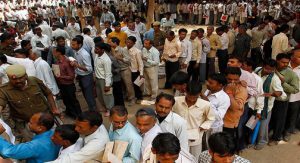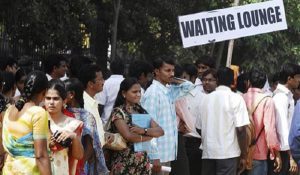The governance outcomes will remain below par till structural transformation is implemented. The top-down approach has the disadvantage of an overblown apex crushing the little people below. Change, sensitive to mitigating the costs, thereof, flexible implementation of norms driven from below, with primacy for real value addition can deliver 100 percent results in reforms, opines Navodita, our Associate Editor, in the weekly column, exclusively for Different Truths.
A lot needs to be done by the government and those related closely to governance, especially in the field of building a strong economy. This time around as elections get closer, can job be on their party agenda – is the big question? What are the other ways in which economic reforms may be brought about?
Prior to jobs, in the past, it was all about boosting economic growth – where again things have taken a focus for the positive. Before growth it was about ending poverty in the 1990s; earlier, in the late 1960s and till the mid-1970s, it was about boosting agriculture, becoming self-sufficient in food and avoiding  famines. Even further back, heavy industrialisation and infrastructure was the mantra in the 1950s. Seventy years on, agriculture has low productivity levels, 40 percent of us are either poor or are vulnerable to poverty; we are still stretching for sustained high real growth; unemployment is high and the participation rate in the workforce is a low 48 percent with women faring worse than men. It is useful to look beyond the efforts made by the successive governments, at the outcomes and ask the question: why are the results always worse than expected?
famines. Even further back, heavy industrialisation and infrastructure was the mantra in the 1950s. Seventy years on, agriculture has low productivity levels, 40 percent of us are either poor or are vulnerable to poverty; we are still stretching for sustained high real growth; unemployment is high and the participation rate in the workforce is a low 48 percent with women faring worse than men. It is useful to look beyond the efforts made by the successive governments, at the outcomes and ask the question: why are the results always worse than expected?
First, transformative change is disruptive. But we have been slow in embedding credible instruments to mitigate the cost of disruption. This increases the risk perception of change, leading to a public pushback on reforms. Consider how poorly we acquire land in public interest. The instruments for identifying, determining and managing the acquisition are so poorly supervised, for ensuring equity and transparency, that massive amounts of mineral resources continue to lie buried in tribal areas, whilst tribes prefer to eke out a subsistence level traditional life, rather than participate in the process of development. The overriding fear of every property owner, or occupier, is of being gypped in the process of acquisition, by forces beyond their control.
Second, managing change successfully requires a governance system good at modern parenting rather than a patriarchal approach directing towards controlling people and events. Our governance systems still follow the colonial legacy of collaborating with entrenched elites to get things done somehow. Those affected at the bottom become a hindrance rather than participants. For us, the political model should be Europe, rather than China. Multiparty politics in India requires sufficient elbow room for diverse political ideologies. The political architecture must be flexible in implementation but prescriptive on the objectives and principles of public management.
Defining inter-governmental mandate more strictly will force governments to work with their mandates.  Consider that Members of Parliament get elected by getting drains made and Members of Legislative Assemblies by promising higher prices for agricultural products or by proposing a separate flag for their state – all areas outside their mandates. The officials must be recruited and managed by the level of government they serve. Fiscal resources, at every level of the government, must be aligned with form, which should fit the functions executed at that level. The governance outcomes will remain below par till structural transformation is implemented. The top-down approach has the disadvantage of an overblown apex crushing the little people below. Change, sensitive to mitigating the costs, thereof, flexible implementation of norms driven from below, with primacy for real value addition can deliver 100 percent results in reforms.
Consider that Members of Parliament get elected by getting drains made and Members of Legislative Assemblies by promising higher prices for agricultural products or by proposing a separate flag for their state – all areas outside their mandates. The officials must be recruited and managed by the level of government they serve. Fiscal resources, at every level of the government, must be aligned with form, which should fit the functions executed at that level. The governance outcomes will remain below par till structural transformation is implemented. The top-down approach has the disadvantage of an overblown apex crushing the little people below. Change, sensitive to mitigating the costs, thereof, flexible implementation of norms driven from below, with primacy for real value addition can deliver 100 percent results in reforms.
While reforms need to be worked on, at the same time, we need to focus on where has the government taken steps to improve a situation. Last week, the Union government made it easier for the industry to hire labour contractually for a fixed, implicitly shorter, term. This facility, which had so far been available to the garments and leather industries has now been extended to all sectors. Nevertheless, the apparent failure of the scheme indicates that labour laws are not the only hurdle to investments and employment at the moment.
What is important is that labour needs to know that employment cannot be guaranteed and that it needs to make efforts to continuously re-skill to remain relevant in the labour markets. Labour markets need to mature to face the onslaught of technology, to deal with business seasonality, and also business cycles. The new policy could be a very small nudge in that direction- suggesting that we have a formal job but its tenure is not ‘permanent’.
Managing this change is a challenge. While the move on fixed-term contracts for labour is a welcome one, it is unlikely to make any material difference to the challenge of unemployment in India, which is the twin problem of very low labour participation and rising unemployment. The economy demands a lot more to deal with this challenge.
The labour participation rate has risen simultaneously; nevertheless, unemployment continues to remain elevated during this month compared to its level in February. As unemployment fails to find a solution, the main agenda on every political party’s manifesto should be jobs, jobs, and jobs. Until we have eradicated unemployment completely, we cannot think of fighting the other evils – poverty and disease.
©Navodita Pande
Photos from the Internet
#Jobless #Unemployment #IndianJobs #LabourJobs #IndianEconomy #EconomyAndPoliticsOfIndia #Poverty #CreatingJobs #Aamonomics #DifferentTruths









 By
By
